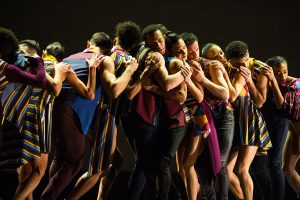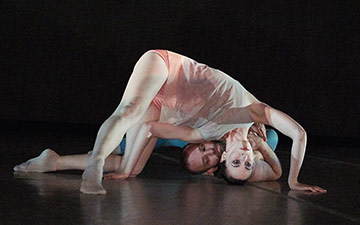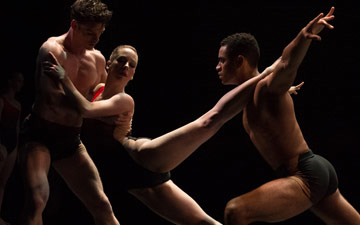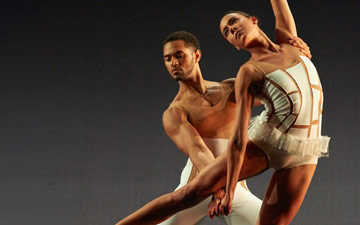
© Chris Hardy. (Click image for larger version)
Amy Seiwert’s Imagery
SKETCH 9: Perspective: Verses, All I Ever Knew and Otra Vez, Otra Vez, Otra Vez
★★★★✰
San Francisco, ODC Theater
18 July 2019
www.asimagery.org
www.odc.dance
The SKETCH series, from Amy Seiwert’s Imagery, is one of my favorite summer dance events in San Francisco. The company dancers are always terrific, both technically and artistically. In fact, watching them in motion is sheer delight, even in moments when the choreography is not necessarily speaking to me. And I love SKETCH’s structure. Each year, Artistic Director Amy Seiwert posits a creative theme or puzzle, and asks ballet-based choreographers to respond during a five-week artistic incubator. At the same time, the dancemakers are challenged to explore different methods of working and to use this mini-residency as a laboratory for experimentation.
Recently Imagery were at ODC Theater (co-presenter of the event), to reveal what had been built and generated for the program’s ninth edition, titled Perspective. The theme: visual projection and dance. The choreographers/premieres: Seiwert’s Verses, Stephanie Martinez’ Otra Vez, Otra Vez, Otra Vez and All I Ever Knew by Imagery’s first Artistic Fellow, Ben Needham-Wood. The result: choreographically strong works with projection elements that while innovative, were extraneous from time to time.
Aptly titled, Seiwert’s Verses was the most cohesive dance on the program; all of its components working in tandem to create an artistic whole. Though here, instead of a song or poem, the larger entity was a contemporary ballet of intricately interlaced parts and verses. Absent was a story and one might characterize the work as abstract, but I think atmospheric is more accurate – a twenty-minute ballet of unassuming spaciousness and expansive tenor.
A projection mosaic of empty stairs, banisters and windows (by video artist Olivia Ting) began on the back wall and traveled to the stage surface throughout the dance, suggesting a big, open space yearning to be filled. Christine Darch’s costumes for the company’s eight dancers were a pleasing yellow, filtering in like rays of sun. And music from The Chopin Project sang through the air, flowing and melodious, yet with a distinct sense of freedom and room. Dancers explored the space with an array of movement qualities; though vastness was by far the primary tone. Arms and legs circled and extended into the ether, far away from the center of the body. The cast cannoned through wavy phrases and catapulted into each other’s arms, choreography rippling from one body to the next. Nothing in Verses was busy or frenetic; it was like a relaxing summer’s day, full of potential and possibility.

© Chris Hardy. (Click image for larger version)
Martinez’ choreographic vocabulary was the highlight of Otra Vez – an intoxicating mélange of ballet, partnered dances like Tango and Pasodoble, even a little formal Fosse-inspired jazz. Otra Vez also felt largely abstract, though, at the same time, its dynamic conversation between movement genres and dance traditions couldn’t help but be emotive. As the cast cycled through duets, pas de trois and group sequences, hands splayed and heels popped. Intense flexion imbued the joints, arms created large arcs, the upper body oozed with a sinuousness and the air was infused with ample, audible breath.
As stunning as Otra Vez’s choreography was, other elements were less resonant. A pale, pale blue, Darch’s gauzy, chiffon costumes felt a mismatch for the dramatic composition. And while Ben Estabrook’s video projections were intriguing, their connection to the piece was unclear. A collage of faces appeared on the back wall, though too briefly to make a statement. There was also a series of “live” geometric grids cast onto the surface of the stage, kind of a Tron throwback to the 1980s. Again, relation to the overall piece was a real question, but my main challenge was actually the live pulsing and shifting. If you have any kind of motion sickness tendencies, that kind of visual is tough, and so there were many sections of the dance that I just wasn’t able to watch.

© Chris Hardy. (Click image for larger version)
After two abstract ballets, Needham-Wood’s All I Ever Knew took things in a different, and welcome, direction. Set to Kishi Bashi’s cinematic, sweeping “151a” album, the ensemble work mines the epic nature of relationships. Joy and excitement were expressed through embrace and sweeping lifts; being “in tune” with each other through unison phrases. In moments of struggle, loneliness and isolation, couples separated and retreated to opposite sides, while chaos and duress read through shaking arms and clenched fists.
At the back of the stage, a wall of boxes framed this journey, as did a small grid suspended above the stage of those same boxes. It was onto these surfaces that Chris Correa projected an array of visuals. A bright blue sky brought a sense of the future to the table, while images of the dancers’ eyes spoke to the emotions that were being explored onstage. Red sparks and blue-green light cubes illuminated the boxes, emphasizing the layered, deeply charged nature of emotional baggage. All I Ever Knew’s video collaboration definitely felt connected to the work. Having said that, the projections that were centered on the suspended grid got lost. Occasionally my eye would venture upward, but most of the time, I was focused on what was happening at stage level. I wonder what the impact would have been if that grid structure had been placed somewhere else.

















You must be logged in to post a comment.